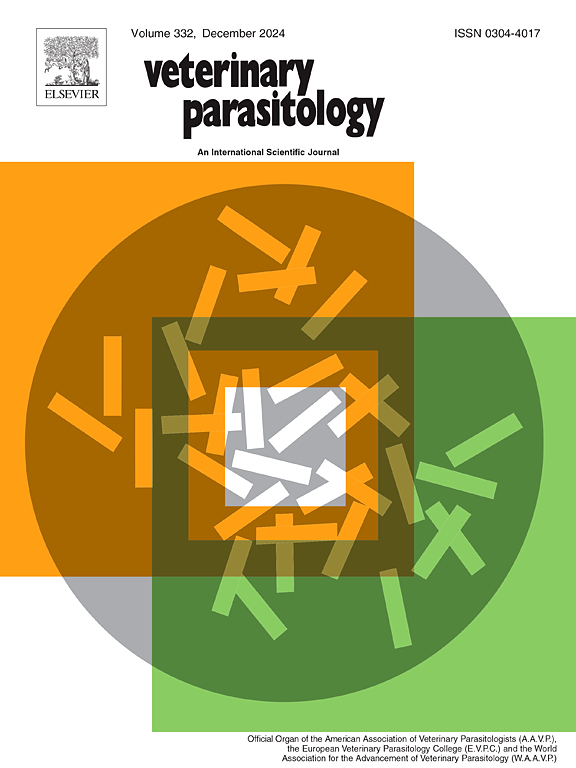Dolphins share Toxoplasma gondii Type II genotypes with terrestrial animals: Evidence of terrestrial T. gondii contamination in marine environments
IF 2.2
2区 农林科学
Q2 PARASITOLOGY
引用次数: 0
Abstract
Toxoplasma gondii is a protozoan parasite that can infect all warm-blooded animals, leading to toxoplasmosis. Dolphins are invaluable sentinel species informing potential risks of zoonotic pathogen infection in humans through raw or undercooked seafood consumption. Between 2019 and 2023, 14 dolphins from coastal New South Wales, Australia were examined as part of ongoing marine animal health monitoring programs. Based on the histological lesions of inflammation associated with protozoal structures, Toxoplasma gondii infection is interpreted to have contributed to morbidity and mortality of four of these dolphins as identified via real-time PCR for B1 and REP genes on genetic material extracted from lung and brain samples. Additional genetic characterisation was performed on three T. gondii dolphin samples utilising multiplex multilocus nested PCR-RFLP (Mn-PCR-RFLP) targeting 13 genetic markers: B1, SAG1, 5’ and 3’ SAG2, alt. SAG2, SAG3, BTUB, GRA6, c22-8, c29-2, L358, PK1, and Apico. A Type II variant genotype, also called ToxoDB PCR-RFLP genotype #3, was identified in four tissues. Three of the samples displayed a unique genotype on the SAG3 marker, and one of the samples showed unique genotypes on both B1 and c22-8 markers. Our findings suggest that T. gondii of the same genotype has been circulating in New South Wales for the past decade. Although temporal data is limited, all examined animals were found stranded during multi-year La Niña events. The notable increase in rainfall in 2022 is considered a potential factor leading to T. gondii infections in these dolphins, likely due to run-off containing feline faecal contamination highlighting the widespread impact of invasive species in Australia.
海豚与陆生动物共享弓形虫II型基因型:海洋环境中陆生弓形虫污染的证据
刚地弓形虫是一种原生动物寄生虫,可以感染所有温血动物,导致弓形虫病。海豚是宝贵的哨兵物种,通过食用生的或未煮熟的海鲜,告知人类感染人畜共患病原体的潜在风险。在2019年至2023年期间,作为正在进行的海洋动物健康监测计划的一部分,对澳大利亚新南威尔士州沿海的14只海豚进行了检查。根据与原生动物结构相关的炎症组织学病变,通过从肺和脑样本中提取的遗传物质的B1和REP基因的实时PCR鉴定,弓形虫感染被解释为导致了其中4只海豚的发病和死亡。利用多重多位点巢式PCR-RFLP (Mn-PCR-RFLP)对三个弓形虫海豚样本进行了额外的遗传表征,目标是13个遗传标记:B1, SAG1, 5 ‘和3 ’ SAG2, alt. SAG2, SAG3, BTUB, GRA6, c22-8, c29-2, L358, PK1和Apico。在4个组织中鉴定出II型变异基因型,也称为弓形虫PCR-RFLP基因型#3。其中3份样品在SAG3标记上显示出独特的基因型,1份样品在B1和c22-8标记上都显示出独特的基因型。我们的研究结果表明,相同基因型的弓形虫在过去十年中一直在新南威尔士州传播。虽然时间数据有限,但所有被检查的动物都在多年的La Niña事件中被发现搁浅。2022年降雨量的显著增加被认为是导致这些海豚感染弓形虫的潜在因素,可能是由于含有猫粪便污染的径流,突显了入侵物种在澳大利亚的广泛影响。
本文章由计算机程序翻译,如有差异,请以英文原文为准。
求助全文
约1分钟内获得全文
求助全文
来源期刊

Veterinary parasitology
农林科学-寄生虫学
CiteScore
5.30
自引率
7.70%
发文量
126
审稿时长
36 days
期刊介绍:
The journal Veterinary Parasitology has an open access mirror journal,Veterinary Parasitology: X, sharing the same aims and scope, editorial team, submission system and rigorous peer review.
This journal is concerned with those aspects of helminthology, protozoology and entomology which are of interest to animal health investigators, veterinary practitioners and others with a special interest in parasitology. Papers of the highest quality dealing with all aspects of disease prevention, pathology, treatment, epidemiology, and control of parasites in all domesticated animals, fall within the scope of the journal. Papers of geographically limited (local) interest which are not of interest to an international audience will not be accepted. Authors who submit papers based on local data will need to indicate why their paper is relevant to a broader readership.
Parasitological studies on laboratory animals fall within the scope of the journal only if they provide a reasonably close model of a disease of domestic animals. Additionally the journal will consider papers relating to wildlife species where they may act as disease reservoirs to domestic animals, or as a zoonotic reservoir. Case studies considered to be unique or of specific interest to the journal, will also be considered on occasions at the Editors'' discretion. Papers dealing exclusively with the taxonomy of parasites do not fall within the scope of the journal.
 求助内容:
求助内容: 应助结果提醒方式:
应助结果提醒方式:


